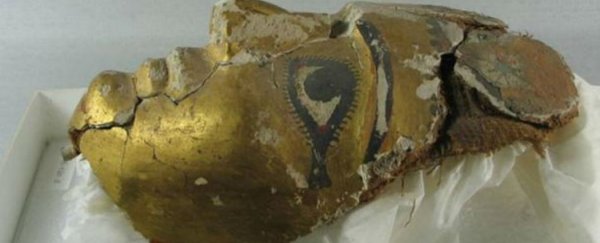A fragment of what could be the earliest copy of the Gospel of Mark - the oldest of the four canonical gospels of Matthew, Mark, Luke, and John, and central to the belief system of Christianity - is set to be published after being discovered in the face mask of an Egyptian mummy.
Not all mummies were created equal - we're used to seeing them contained by stunning sarcophagi and masks coated in gold, but only Egyptian royalty were honoured with such finery. When regular citizens died and were mummified, their masks were made from simple papyrus - a plant-based, paper-thin material - which was glued together in layers and painted.
And while papyrus was obviously a whole lot cheaper to produce than gold, it came in limited supply, so people often recycled it, just like how kids use old newspapers to make Papier-mâché. Now, researchers have figured out how to loosen the glue that holds these papyrus layers together, thousands of years after it was applied, so they can be extracted from the mask with the original ink writings still intact.
A team of scientists and scholars led by Craig Evans, an expert in Biblical texts at the Acadia Divinity College in the US, has used this technique to extract hundreds of ancient texts from the masks of a bunch of different mummies, the content of which isn't only of religious significance. More notable finds include tales and philosophical musings of Homer, the ancient Greek poet.
"We're recovering ancient documents from the first, second and third centuries. Not just Christian documents, not just biblical documents, but classical Greek texts, business papers, various mundane papers, personal letters," Evans told Owen Jarus at LiveScience. "From a single mask, it's not strange to recover a couple dozen or even more [new texts]. We're going to end up with many hundreds of papyri when the work is done, if not thousands."
Because a number of these personal and business correspondence included dates, the team was able to date the Gospel of Mark fragment to the 1st century because, while it wasn't dated, it was found in the mask with documents that were.
The researchers have been careful to point out that while they had to make the difficult decision to destroy the masks in order to discover the documents that hold them together, these are not "museum-quality pieces", Evans told LiveScience, and more archaeological value could lie in the deconstructed materials.
Due to the value of what's already been discovered, and the fact that whatever's found still belongs to the museum, university, or private collector that owns of the mummy, Evans's team has been sworn to secrecy regarding the contents. The only reason they're allowed to speak about the Gospel of Mark fragment at all is because news of its existence was leaked in 2012.
If the team's first century calculation is accurate for the age of this fragment, it predates the current oldest copy of the Gospel of Mark by almost 150 years. But skepticism over dating practices will remain until the document is published and independent researchers are allowed a look-in. For now, we have to settle for what Evans says they've done to date the artefact.
Jarus explains at LiveScience:
"Evans says that the text was dated through a combination of carbon-14 dating, studying the handwriting on the fragment and studying the other documents found along with the gospel. These considerations led the researchers to conclude that the fragment was written before the year 90. With the nondisclosure agreement in place, Evans said that he can't say much more about the text's date until the papyrus is published."
Publication is expected to happen some time this year.
Source: LiveScience
